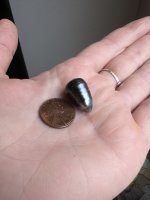Tahitian Pearls Defined
Tahitian pearls are bead-nucleated pearls grown in the gonad of the Pinctada margaritifera mollusk in French Polynesia.
Tahitian Pearls - Among the Most Beautiful in the World
Tahitian pearls are produced in the black-lipped oyster Pinctada margaritifera, in and around Tahiti and the French Polynesian islands. This oyster itself is quite large - sometimes over 12 inches (30 cm) across and weighing as much as 10 pounds (4.5 Kg) - which often results in much larger-than-average pearls. The pearls are unique because of their natural dark colors.
Most "black" Tahitian pearls are not actually black, but are instead silver, charcoal, or a multitude of colors with the dominant color being green. Truly black pearls are quite rare.

Fine Tahitian pearls exhibiting the coveted peacock tones
Tahitian Pearls - Not really from Tahiti!
Although Tahitian pearls are thought by many to be solely a product of Tahiti, this is in fact not true. Tahiti is the commercial center and trading hub for the bulk of the industry; however, Tahiti does not have any pearl farms located on the island. The farms are instead scattered throughout French Polynesia, as far east as the Gambier Islands, and beyond French Polynesia to the west into the Micronesian Islands. Australia, the Seychelles, and Vietnam have all produced black pearls as well, but those cannot be referred to as Tahitian pearls.

Workers tending to pearl shells on Marutea Sud in French Polynesia
Almost Fished to Extinction
Not only are the pearls beautiful, but the black-lipped oyster's mother-of-pearl inner shell is also extremely attractive. By the early part of the 20th century, before conservation and repopulation efforts began, the oyster had been hunted to extinction for its shell alone.
Tahitian Pearl Farming Begins
Tahitian pearl farming has much later commercial origins than other types of cultured pearls. In the early 1960's a man by the name of Jean-Marie Domard began experimenting with the Pinctada margaritifera using Japanese culturing techniques. In 1962, Mr. Domard successfully nucleated five thousand oysters, and after 3 years harvested more than one thousand Tahitian pearls.
Related Articles and Forum Threads:
Tahitian pearls are bead-nucleated pearls grown in the gonad of the Pinctada margaritifera mollusk in French Polynesia.
Tahitian Pearls - Among the Most Beautiful in the World
Tahitian pearls are produced in the black-lipped oyster Pinctada margaritifera, in and around Tahiti and the French Polynesian islands. This oyster itself is quite large - sometimes over 12 inches (30 cm) across and weighing as much as 10 pounds (4.5 Kg) - which often results in much larger-than-average pearls. The pearls are unique because of their natural dark colors.
Most "black" Tahitian pearls are not actually black, but are instead silver, charcoal, or a multitude of colors with the dominant color being green. Truly black pearls are quite rare.
Fine Tahitian pearls exhibiting the coveted peacock tones
Tahitian Pearls - Not really from Tahiti!
Although Tahitian pearls are thought by many to be solely a product of Tahiti, this is in fact not true. Tahiti is the commercial center and trading hub for the bulk of the industry; however, Tahiti does not have any pearl farms located on the island. The farms are instead scattered throughout French Polynesia, as far east as the Gambier Islands, and beyond French Polynesia to the west into the Micronesian Islands. Australia, the Seychelles, and Vietnam have all produced black pearls as well, but those cannot be referred to as Tahitian pearls.
Workers tending to pearl shells on Marutea Sud in French Polynesia
Almost Fished to Extinction
Not only are the pearls beautiful, but the black-lipped oyster's mother-of-pearl inner shell is also extremely attractive. By the early part of the 20th century, before conservation and repopulation efforts began, the oyster had been hunted to extinction for its shell alone.
Tahitian Pearl Farming Begins
Tahitian pearl farming has much later commercial origins than other types of cultured pearls. In the early 1960's a man by the name of Jean-Marie Domard began experimenting with the Pinctada margaritifera using Japanese culturing techniques. In 1962, Mr. Domard successfully nucleated five thousand oysters, and after 3 years harvested more than one thousand Tahitian pearls.
Related Articles and Forum Threads:

